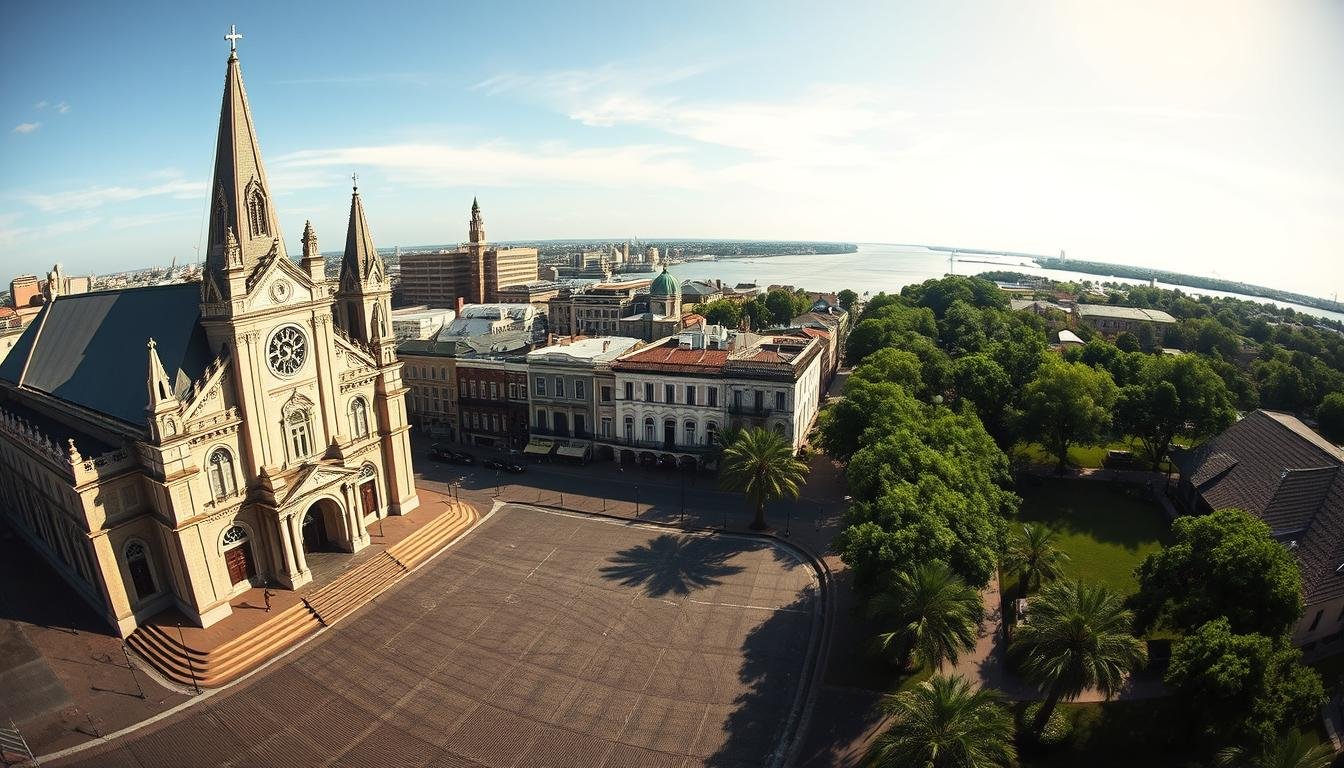As a local, I’m excited to share with you the rich history and vibrant culture of our city’s iconic landmarks. The French Quarter and Garden District are just a few areas filled with stories of the past.
From the architecture to the cultural events, these historic landmarks play a significant role in shaping our community’s identity. Preserving these sites is crucial for future generations to understand and appreciate our heritage.
Our city’s history is alive in its landmarks, and exploring them is a journey through time. Let’s take a closer look at the significance of these sites and the efforts to preserve them.
Key Takeaways
- Discover the rich history of the French Quarter and its architectural significance.
- Explore the Garden District’s historic mansions and their cultural importance.
- Learn about the preservation efforts that keep these landmarks alive.
- Understand the role these sites play in shaping the local community’s identity.
- Find out how to experience these historic sites during your visit.
The Allure of Historic Preservation in New Orleans
New Orleans, a city steeped in history, owes much of its charm to the preservation of its historic sites. As a local, I’ve seen firsthand how these sites bring our community together and attract visitors from all over the world.
Walking through the French Quarter, you can’t help but feel the weight of history – from the ancient architecture to the stories of the past that seem to seep from the very walls. It’s this unique blend of history and culture that makes New Orleans so special.
Why Historic Sites Matter
Historic sites are more than just old buildings; they’re a window into the past, providing a tangible connection to the people and events that shaped our city. By preserving these sites, we can learn from history and appreciate the cultural heritage that makes New Orleans so rich and diverse.
Some of the most famous historic places in New Orleans include the French Quarter, with its iconic architecture and vibrant street life, and the Garden District, known for its stunning antebellum mansions.
| Historic Site | Location | Significance |
|---|---|---|
| French Quarter | Central New Orleans | Oldest neighborhood in New Orleans, known for its architecture and nightlife |
| Garden District | Uptown New Orleans | Famous for its antebellum mansions and picturesque gardens |
| St. Louis Cathedral | Jackson Square, French Quarter | Historic cathedral and iconic landmark |
The Role of Heritage in Community Identity
Our heritage plays a significant role in shaping our community’s identity and influencing our daily lives. By preserving historic sites, we can maintain the unique character of our city and ensure that future generations can appreciate and learn from our history.
As we continue to grow and evolve as a city, it’s essential that we balance progress with preservation, ensuring that our historic sites remain an integral part of our community’s fabric.
Iconic Landmarks You Can’t Miss
At the core of New Orleans’ historic district lies the French Quarter, a treasure trove of cultural and historical significance. This vibrant neighborhood is where the city’s rich past converges with its lively present.
The French Quarter: A Cultural Epicenter
The French Quarter, also known as the Vieux Carré, is the oldest neighborhood in New Orleans. Its historic architecture, jazz clubs, and cultural landmarks make it a unique cultural epicenter. As you stroll through its charming streets, you’ll discover a blend of French, Spanish, and African influences that have shaped the area’s identity.
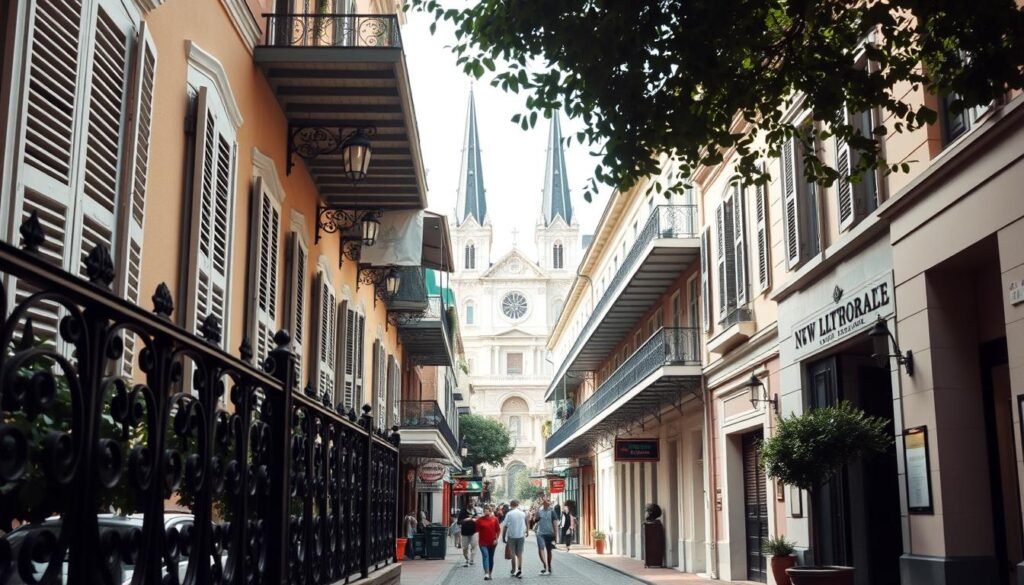
St. Louis Cathedral: Architectural Marvel
Located in Jackson Square, St. Louis Cathedral is one of the most iconic landmarks in the French Quarter. This beautiful cathedral, with its stunning Romanesque Revival architecture, has been a silent witness to the city’s history since 1794. Its three spires and striking façade make it a must-visit attraction.
Jackson Square: A Gathering Place
Jackson Square is more than just a historic park; it’s a vibrant gathering place where locals and tourists alike come to enjoy the city’s atmosphere. Surrounded by street performers, artists, and historic buildings, the square is the perfect spot to experience the essence of New Orleans. The square’s historic significance and lively ambiance make it an unforgettable part of any visit to the French Quarter.
Exploring the Garden District
New Orleans’ Garden District is a living, breathing testament to the city’s rich cultural heritage. As you wander through its picturesque streets, you’ll be surrounded by stunning examples of antebellum architecture, beautiful gardens, and a glimpse into the lives of the people who once called this place home.
Antebellum Architecture: Historical Insights
The Garden District is renowned for its impressive collection of antebellum mansions, showcasing a variety of architectural styles, including Greek Revival, Italianate, and Second Empire. These grand homes, built primarily between the 1830s and 1860s, not only reflect the wealth and status of their former occupants but also provide a unique window into the history of New Orleans during a period of significant growth and change.
For those interested in exploring these historic homes, I recommend taking a historic tour of the Garden District, which offers a deeper understanding of the architectural styles and the historical context in which they were built.
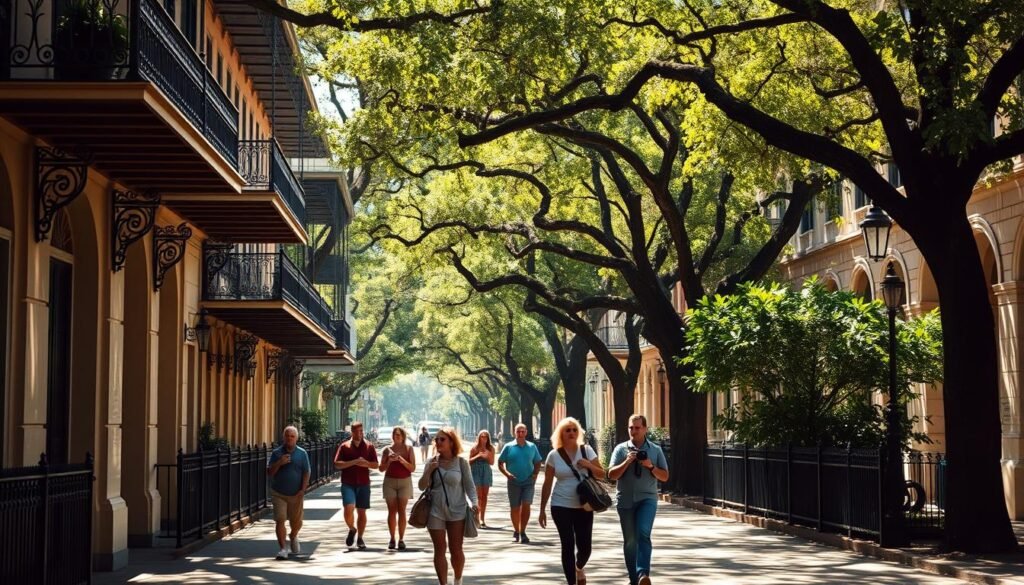
Lafayette Cemetery No. 1: A Window into the Past
Lafayette Cemetery No. 1, located in the heart of the Garden District, is one of New Orleans’ most historic cemeteries. Established in 1833, it’s a fascinating example of the city’s unique above-ground burial tradition, born out of the necessity to cope with the city’s low elevation and high water table.
As you stroll through the cemetery, you’ll notice the elaborate mausoleums and grave markers, each telling a story about the person or family buried there. From the grand tombs of wealthy families to the simpler graves of those less fortunate, Lafayette Cemetery No. 1 is a poignant reminder of New Orleans’ rich history and cultural heritage.
Visiting the Garden District, including Lafayette Cemetery No. 1, is among the best historic sites in New Orleans to explore. It’s an experience that combines history, architecture, and a touch of the city’s unique cultural spirit, making it a must-visit for anyone interested in historic tours New Orleans.
Battlegrounds of History
From the mystique of voodoo to the echoes of war, New Orleans’ battlegrounds offer a glimpse into our complex past. As a city with a rich military and spiritual history, New Orleans provides a unique lens through which to explore the events and practices that have shaped its identity.
The Historic Voodoo Museum: Understanding New Orleans’ Spiritual Roots
The Historic Voodoo Museum is a fascinating destination that sheds light on the spiritual practices that have influenced our city’s culture. With a collection of artifacts, including voodoo dolls, gris-gris bags, and other ritualistic items, the museum provides a captivating look at the history and significance of voodoo in New Orleans.
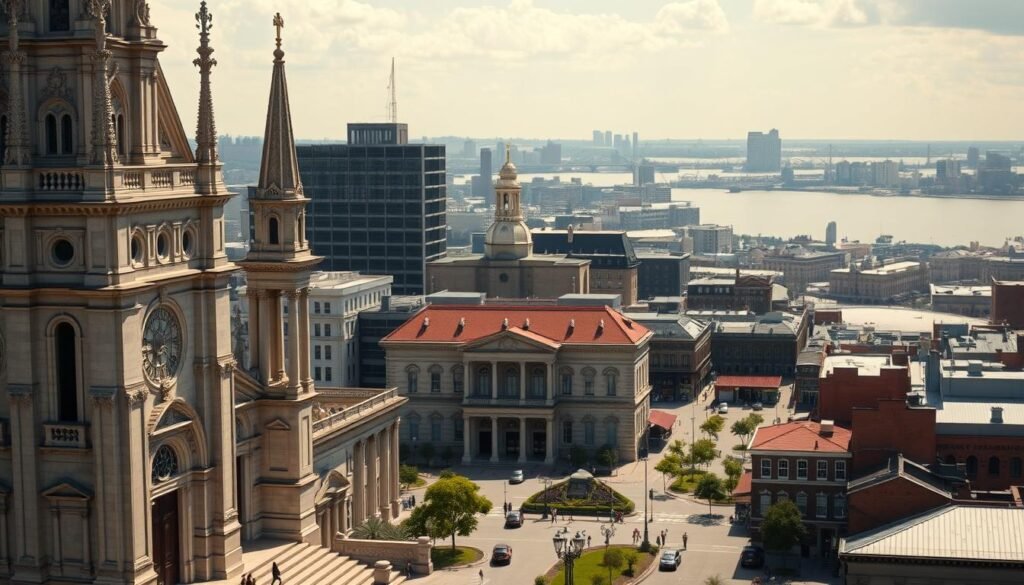
Visitors to the museum can gain a deeper understanding of how voodoo has impacted our city’s development, from its early roots in African diasporic traditions to its contemporary practice. The museum serves as a testament to the enduring power of spiritual practices in shaping our community.
The Chalmette Battlefield: A Key War Site
The Chalmette Battlefield is another significant historical site in New Orleans, commemorating the Battle of New Orleans during the War of 1812. This pivotal battle marked a crucial moment in American history, as American forces led by General Andrew Jackson defeated a large British army, securing a vital victory that shaped the future of the United States.
The battlefield is now part of the Jean Lafitte National Historical Park and Preserve, offering visitors a chance to explore the grounds and learn about the events that took place there. A visit to the Chalmette Battlefield is a must for anyone interested in military history and the role it has played in shaping our nation.
| Historic Site | Significance | Visitor Experience |
|---|---|---|
| The Historic Voodoo Museum | Showcases the history and significance of voodoo in New Orleans | Explore artifacts, learn about voodoo practices, and understand its cultural impact |
| The Chalmette Battlefield | Commemorates the Battle of New Orleans during the War of 1812 | Visit the battlefield, learn about the battle’s significance, and explore the surrounding historical park |
Both the Historic Voodoo Museum and the Chalmette Battlefield are must-see historic attractions in New Orleans, offering unique insights into the city’s spiritual and military heritage. By visiting these sites, you’ll gain a deeper appreciation for the complex history that has shaped this vibrant city.
Museums That Tell the Story
Museums in New Orleans are more than just repositories of artifacts; they’re gateways to understanding the city’s complex history. As a local, I’ve had the privilege of exploring these institutions, and I’m always struck by the depth and richness they bring to our understanding of the past.
New Orleans is home to a diverse range of museums, each offering a unique perspective on the city’s history. Two of the most significant institutions are The National WWII Museum and The Louisiana State Museum.
The National WWII Museum: A Journey Through Time
The National WWII Museum is a must-visit attraction that takes you on a journey through one of the most pivotal moments in modern history. With a vast collection of artifacts, personal stories, and immersive exhibits, this museum provides a comprehensive look at the American experience in World War II.
- Personal Stories: Hear directly from veterans and those who lived through the war.
- Immersive Exhibits: Engage with interactive displays that recreate the sights and sounds of the era.
- Historical Artifacts: See a wide range of items, from uniforms and equipment to personal belongings.
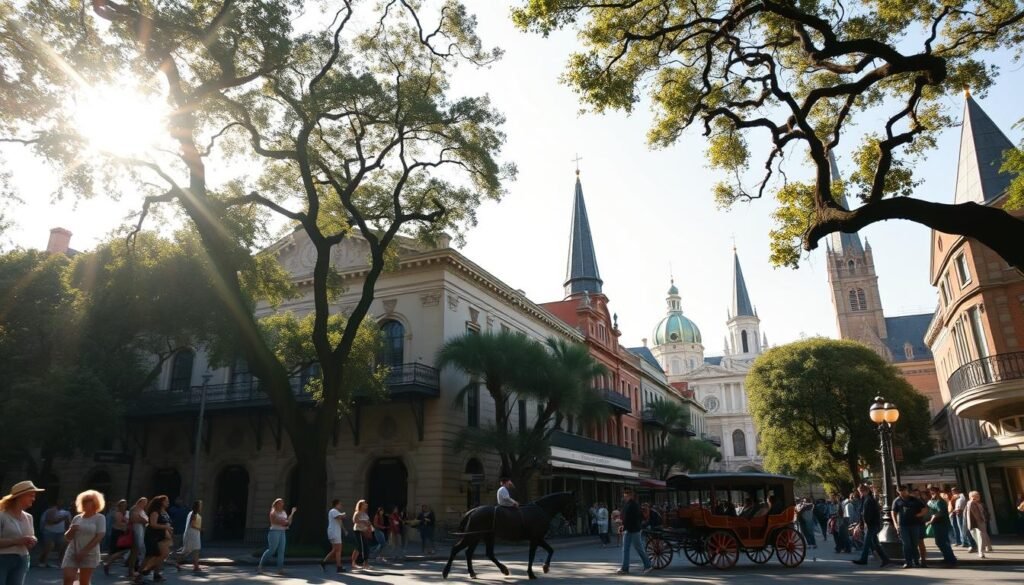
The Louisiana State Museum: Showcasing the Region’s Rich History
The Louisiana State Museum is another gem, offering insights into the broader history of the region. From the colonial era through to the present day, this museum covers a wide range of topics, including the history of New Orleans and the state’s development.
Some highlights include:
- The Creole Port exhibit, which explores the cultural and economic significance of the port of New Orleans.
- The River Road exhibit, showcasing the history and heritage of the Mississippi River.
- A collection of historic artifacts, including items related to the Civil War and Reconstruction.
Both museums are essential stops for anyone looking to understand the complex tapestry of New Orleans’ history. Whether you’re a local or just visiting, they offer a compelling narrative that enriches your appreciation of this vibrant city.
Hidden Gems of New Orleans
Beyond the well-trodden paths of New Orleans’ famous historic places lies a treasure trove of hidden gems waiting to be discovered. As a local, I’m excited to share with you some of these lesser-known sites that are sure to captivate your imagination.
The Historic Saenger Theatre: A Marvel of Design
The Historic Saenger Theatre is a testament to the city’s rich cultural heritage. Opened in 1927, this stunning example of Baroque Revival architecture was designed by the renowned firm of Emile Weil. With its intricate details and ornate decorations, it’s a must-visit for anyone who appreciates the finer things in life.
The theatre has been meticulously restored to its former glory and now hosts a variety of performances, from concerts to film screenings. Whether you’re a history buff or simply looking for a unique experience, the Saenger Theatre is sure to leave you in awe.
The Old U.S. Mint: A Multi-History Experience
The Old U.S. Mint, located in the heart of the French Quarter, is another hidden gem that’s worth exploring. Built in 1838, this historic building served as a mint during the Civil War era and is now home to the New Orleans Jazz National Historical Park and the Louisiana State Museum’s Jazz Collection.
Visitors can explore the mint’s rich history through guided tours, which offer a glimpse into the lives of the people who worked here, as well as the city’s jazz heritage. The mint also hosts various exhibitions and events throughout the year, making it a vibrant cultural hub.
Here’s a comparison of these two hidden gems:
| Historic Site | Year Established | Primary Use |
|---|---|---|
| The Historic Saenger Theatre | 1927 | Performing Arts Venue |
| The Old U.S. Mint | 1838 | Museum and Historical Park |
Both the Historic Saenger Theatre and the Old U.S. Mint are testaments to New Orleans’ enduring legacy and its ability to preserve the past while embracing the present. As you explore these hidden gems, you’ll discover that the city’s history is not just about grand landmarks, but also about the intricate details that make it so unique.
The Role of Tours in Enriching Historical Knowledge
Tours play a vital role in uncovering the historical treasures of New Orleans. The city’s rich history is best experienced through its diverse range of tours, which cater to different interests and preferences.
Whether you’re a history buff, a ghost enthusiast, or simply a curious traveler, New Orleans has a tour that’s perfect for you. The city’s historic sites are not just landmarks; they’re gateways to understanding the cultural and historical context of the region.
Walking Tours vs. Guided Bus Tours
When it comes to exploring New Orleans’ historic sites, visitors have the option of choosing between walking tours and guided bus tours. Each has its unique advantages.
Walking tours offer an intimate and immersive experience, allowing participants to explore the city’s historic districts on foot. This type of tour is ideal for those who want to appreciate the architectural details and historical significance of landmarks up close.
Guided bus tours, on the other hand, provide a broader overview of the city’s historical landscape. They’re perfect for those with limited time or who prefer to cover more ground without the exertion of walking.
Comparison of Tour Types
| Tour Type | Experience | Ideal For |
|---|---|---|
| Walking Tours | Intimate, immersive | History enthusiasts, architecture buffs |
| Guided Bus Tours | Broad overview, convenient | Time-constrained visitors, those with mobility issues |
Unique Thematic Tours: From Ghosts to History
New Orleans is renowned for its unique thematic tours, which range from ghost tours that explore the city’s haunted history to history-focused tours that delve into the city’s cultural heritage.
Ghost tours are a favorite among visitors, offering a spine-tingling experience as they explore the city’s most haunted sites. These tours provide a fascinating insight into New Orleans’ history and the legends that have shaped its identity.
History-focused tours, on the other hand, offer a deeper understanding of the city’s past, covering topics from the Civil War to the Civil Rights Movement. These tours are led by knowledgeable guides who bring history to life with their stories and insights.
In conclusion, New Orleans’ historic tours offer something for everyone. Whether you’re interested in history, ghosts, or simply exploring the city’s cultural heritage, there’s a tour that’s right for you.
Culinary History of New Orleans
In the heart of New Orleans, food is more than just a meal, it’s a journey through history. The city’s culinary landscape is a reflection of its diverse cultural heritage, shaped by French, Spanish, African, and Native American influences. As you wander through the historic sites in New Orleans’ French Quarter, the aromas of Creole cuisine waft through the air, enticing visitors to explore the city’s gastronomic delights.
Famous Restaurants with Rich Histories
New Orleans is home to numerous iconic restaurants that have been serving up Creole classics for decades. One such establishment is Dooky Chase’s Restaurant, a legendary eatery that has been a cornerstone of the community since 1941. Known for its gumbo z’herbes and other Creole staples, Dooky Chase’s has been a favorite among locals and visitors alike.
Another historic restaurant is Antoine’s, which claims to be the oldest continuously operating restaurant in the United States, dating back to 1840. This venerable institution has hosted countless celebrities and dignitaries, offering a taste of traditional Creole cuisine in an atmosphere steeped in history.
The Story Behind Classic Creole Dishes
Creole cuisine is a unique blend of flavors and techniques, reflecting the cultural melting pot that is New Orleans. Dishes like gumbo, jambalaya, and beignets are more than just delicious; they’re a testament to the city’s history and cultural heritage.
- Gumbo: A hearty stew that combines ingredients from various cultures, including okra from Africa, rice from Europe, and a dash of Native American spices.
- Jambalaya: A one-pot dish that brings together sausage, chicken, and rice, showcasing the city’s multicultural influences.
- Beignets: These sweet fried dough pastries, covered in powdered sugar, are a classic New Orleans treat, enjoyed at Cafe du Monde since 1862.
These classic Creole dishes are not just meals; they’re a culinary journey through the history and culture of New Orleans. As you savor these flavors, you’re experiencing a piece of the city’s heritage, shaped by its historic sites and cultural traditions.
Preservation Challenges and Achievements
Preserving New Orleans’ historic sites is an ongoing challenge, but it’s also an opportunity to make a positive impact on our community. As we’ve explored the best historic sites in New Orleans, it’s clear that these landmarks are not just relics of the past, but vibrant spaces that shape our cultural identity.
Restoring the Past for the Future
Recent restoration projects have made a significant difference in maintaining the integrity of new orleans historic sites. For instance, the St. Louis Cathedral has undergone extensive renovations to restore its original grandeur. Such projects not only preserve our history but also enhance the overall aesthetic of the French Quarter.
Community-Led Preservation Efforts
Community efforts are driving historic site preservation in New Orleans. Local organizations and volunteers work tirelessly to protect and promote our cultural heritage. By supporting these initiatives, we can ensure that the best historic sites in new orleans continue to thrive for generations to come.
As we look to the future, it’s clear that preserving new orleans historic sites requires a collective effort. By working together, we can safeguard our city’s rich history and cultural identity, making it possible for visitors and locals alike to continue experiencing the unique charm of New Orleans.
FAQ
What are the must-see historic attractions in New Orleans?
New Orleans is home to many iconic historic sites, including St. Louis Cathedral, Jackson Square, and the French Quarter. You can also explore the Garden District, visit the Chalmette Battlefield, or take a stroll through Lafayette Cemetery No. 1.
What historic sites in New Orleans are related to the city’s spiritual roots?
The Historic Voodoo Museum is a unique site that sheds light on New Orleans’ spiritual practices, including voodoo. You can also visit St. Louis Cathedral, which is a beautiful example of Gothic Revival architecture and a significant spiritual site.
What types of tours are available to explore New Orleans’ historic sites?
You can take a walking tour, guided bus tour, or unique thematic tour to explore New Orleans’ historic sites. Some popular options include ghost tours, history-focused tours, and culinary tours that highlight the city’s famous Creole cuisine.
What are some of the preservation challenges facing New Orleans’ historic sites?
New Orleans’ historic sites face many preservation challenges, including damage from natural disasters, aging infrastructure, and the need for ongoing restoration efforts. Community efforts and restoration projects are underway to address these challenges.
How can I get involved in preserving New Orleans’ historic sites?
You can support local preservation efforts by volunteering with organizations that work to protect and restore historic sites. You can also visit and support local museums, historic homes, and other cultural institutions.
What are some of the best historic sites to visit in the French Quarter?
The French Quarter is home to many iconic historic sites, including Jackson Square, St. Louis Cathedral, and the French Market. You can also explore the historic streets and admire the architecture, visit historic homes, or take a guided tour.
Are there any historic sites in New Orleans that are related to significant wars or battles?
Yes, the Chalmette Battlefield is a key site that commemorates the Battle of New Orleans during the War of 1812. You can also visit the National WWII Museum, which is a world-renowned museum that tells the story of the American experience in World War II.
Can I visit historic sites in New Orleans that are related to the city’s culinary history?
Yes, you can visit famous restaurants with rich histories, such as Dooky Chase’s Restaurant or Cafe du Monde, to experience the city’s iconic Creole cuisine. You can also take a culinary tour to explore the city’s food history.
